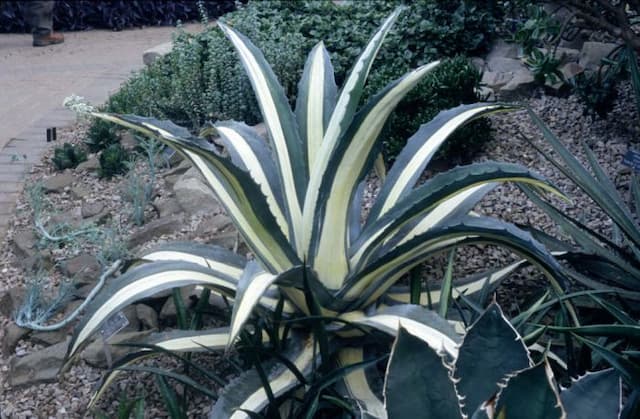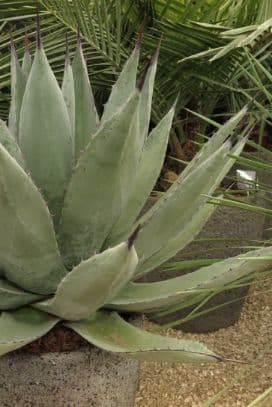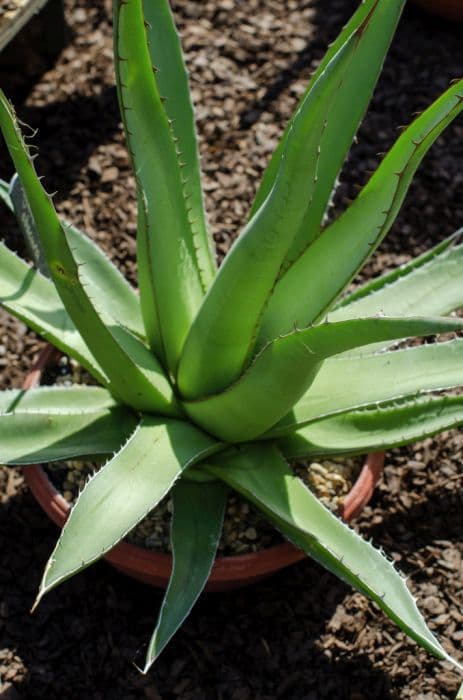Plantain Lily Hosta 'Sagae' (v)

ABOUT
Hosta 'Sagae' features a distinctive appearance that begins with its broad, pointed leaves. These leaves have a unique variegation pattern; they are bordered by a creamy yellow to white margin that surrounds a blue-green to green center. The variegation can be quite striking and may become more pronounced as the plant matures throughout the growing season. The leaves themselves are thick and have a somewhat wavy texture, giving them a corrugated look. This textural element adds to the plant's visual appeal, creating interplay with light and shadow across the surface of the foliage. In terms of flowering, Hosta 'Sagae' produces tall flower spikes that rise above the foliage during the summer months. The flowers are typically lavender or pale purple, bell-shaped, and held aloft on slender stems. These blooms can be a draw for pollinators like bees and can add a vertical element to the plant's otherwise mounding form. It's worth noting that the unique foliage is the most valued aspect of Hosta 'Sagae', with its variegation and texture making it an excellent choice for adding contrast and interest to shaded garden areas.
About this plant
 Names
NamesFamily
Asparagaceae
Synonyms
Funkia, Plantain Lily, Giboshi
Common names
Hosta 'Sagae'
 Toxicity
ToxicityTo humans
Hostas, commonly known as plantain lilies, are not considered highly toxic to humans. Ingestion of parts of the hosta plant might cause mild stomach upset, but it is generally not known for severe toxicity or serious consequences. However, it is advised that the plant should not be consumed.
To pets
Hostas, or plantain lilies, are toxic to pets, particularly to dogs and cats. If pets ingest any part of a hosta plant, they can suffer from symptoms of plant poisoning. These symptoms might include vomiting, diarrhea, and depression. In severe cases, ingestion can lead to more serious effects and potentially, without treatment, have lethal consequences. If you suspect your pet has ingested hosta, it is important to contact your veterinarian immediately.
 Characteristics
CharacteristicsLife cycle
Perennials
Foliage type
Deciduous
Color of leaves
Variegated
Flower color
Lavender
Height
2 feet 60 cm
Spread
5 feet 150 cm
Plant type
Herb
Hardiness zones
3
Native area
Asia
Benefits
 General Benefits
General Benefits- Ornamental Appeal: The Hosta 'Sagae' features attractive, variegated foliage that provides visual interest in shade gardens or as landscape accents.
- Shade Tolerance: It thrives in shaded areas where many other plants struggle to grow, making it a valuable addition to shady garden spots.
- Easy Maintenance: This plant is known for being low-maintenance, requiring minimal care once established.
- Drought Resistance: Though it prefers moist soil, Hosta 'Sagae' can tolerate periods of drought, making it resilient in varying weather conditions.
- Soil Adaptability: It can grow in a wide range of soil types, as long as there is adequate drainage.
- Garden Design Versatility: Hosta 'Sagae' can be used in a variety of garden styles, including formal, cottage, and woodland gardens.
- Pest Resistance: Hosta 'Sagae' is resistant to many pests, reducing the need for chemical treatments in the garden.
- Seasonal Interest: With its long-lasting leaves, this plant provides interest from spring until fall, and its flowers add a seasonal bonus usually in early to mid-summer.
- Cold Hardy: The plant is winter hardy in many climates, making it a reliable perennial in cooler regions.
- Compatibility: Hosta 'Sagae' complements other shade-loving plants, allowing for harmonious garden compositions.
 Medical Properties
Medical PropertiesThis plant is not used for medical purposes.
 Air-purifying Qualities
Air-purifying QualitiesThis plant is not specifically known for air purifying qualities.
 Other Uses
Other Uses- Landscape Design Accents: The Hosta 'Sagae', with its variegated foliage, provides a striking contrast when planted among green-leaved plants, creating visually appealing garden designs.
- Creative Containers: They can be utilized in containers for designing patio or balcony gardens, where ground space is limited.
- Natural Mulch: When the leaves of Hosta 'Sagae' die back, they can be left in place to decompose, acting as a natural mulch that enriches the soil and retains moisture.
- Photography Backdrops: The bold foliage of Hosta 'Sagae' offers photographers a lush, textured background for plant and garden photography.
- Art Projects: The large leaves can be used as natural stencils or as canvases for garden art projects with children or artists.
- Borders and Edging: Hosta 'Sagae' can be planted in rows to create defined borders or edging along walkways and garden beds.
- Thematic Gardens: They are perfect for use in thematic gardens such as woodland or shade gardens to enhance the overall aesthetic.
- Erosion Control: Hosta 'Sagae' can be helpful in stabilizing soil and preventing erosion in shady, sloped areas due to its clumping growth habit.
- Underplanting for Trees and Shrubs: Its shade tolerance makes it an ideal underplanting choice for larger trees and shrubs, filling in the space below canopies.
- Culinary Creativity: While not commonly used for culinary purposes, young, tender Hosta leaves have been used in some cultures as a unique, edible garnish for special dishes.
Interesting Facts
 Feng Shui
Feng ShuiThe Hosta is not used in Feng Shui practice.
 Zodiac Sign Compitability
Zodiac Sign CompitabilityThe Hosta is not used in astrology practice.
 Plant Symbolism
Plant Symbolism- Resilience – Hostas are known for their hardiness and ability to thrive in shade, symbolizing the ability to persevere through challenging conditions.
- Devotion – With their lush foliage that often returns in greater abundance each year, hostas can represent loyalty and ongoing support in relationships.
- Welcoming – Because hostas are often used in shade gardens to create a lush, inviting atmosphere, they can symbolize hospitality and the welcome of visitors.
 Water
WaterThe Variegated Hosta should be watered deeply once a week, allowing the soil to become slightly dry between waterings. The amount of water needed will vary with the size of the plant and the weather conditions, but a general guide is to use about 1 gallon of water for a medium-sized plant each time you water. During the peak summer months, you may need to water more frequently, especially if the weather is particularly hot or dry. Always check the soil moisture level before watering to avoid overwatering, which can lead to root rot.
 Light
LightVariegated Hostas prefer dappled shade or morning sun with afternoon shade. A location under a tree where sunlight filters through or on the north side of a building where direct sun is limited is ideal. Too much direct sunlight can scorch the leaves, while too little can reduce the vibrancy of the variegation and overall plant vigor.
 Temperature
TemperatureVariegated Hostas thrive in temperatures ranging from 50 to 80 degrees Fahrenheit but can tolerate temperatures as low as 30 degrees and as high as 90 degrees for short periods. The ideal temperature for robust growth and health is between 60 and 70 degrees. It is important to protect the plant from frost, which can damage the foliage.
 Pruning
PruningPruning for Variegated Hostas is mainly to remove dead or damaged leaves and spent flower stalks to maintain a tidy appearance and promote plant health. This should be done as needed throughout the growing season. The best time for major clean-up is in the early spring before new growth begins or immediately after the first few frosts in the fall when the plant goes dormant.
 Cleaning
CleaningAs needed
 Soil
SoilThe Hosta, commonly known as 'Funkia', thrives in well-draining soil rich in organic matter. A balanced soil mix containing equal parts of loam, peat moss, and perlite or pine bark is ideal. Their preferred soil pH is slightly acidic to neutral, ranging from 6.5 to 7.5.
 Repotting
RepottingFunkias do not require frequent repotting and can thrive in the same container for several years. They should be repotted only when they outgrow their current pot, which typically occurs every 3 to 5 years.
 Humidity & Misting
Humidity & MistingHosta 'Sagae', or Funkia, prefers moderate humidity levels but is quite adaptable. Ensuring good air circulation around the plant helps maintain healthy humidity conditions.
 Suitable locations
Suitable locationsIndoor
Keep in bright, indirect light with well-draining soil.
Outdoor
Plant in partial to full shade, in moist, rich soil.
Hardiness zone
3-9 USDA
 Life cycle
Life cycleThe Hosta 'Sagae' (commonly known as Funkia or Plantain Lily) begins its life as a dormant rhizome or division planted in the soil, where, in early spring, it starts to produce shoots and unfurl its decorative, variegated leaves. It enters a phase of vegetative growth during spring and early summer, with leaves reaching their full size and creating a lush mound. By mid to late summer, it sends up tall flower stalks that bear lavender or white trumpet-shaped flowers, attractive to bees and other pollinators, followed by seed pod development. After flowering, the plant continues to photosynthesize and store energy in its rhizomes for the next season. With the onset of fall and cooler temperatures, the foliage begins to die back, and the plant enters a period of dormancy through the winter months. Hosta 'Sagae' completes its life cycle by re-emerging from dormancy the following spring, ready to grow and reproduce once more.
 Propogation
PropogationPropogation time
Late summer to early fall
Propogation: Hosta 'Sagae', commonly known as Funkia or Plantain Lily, is best propagated in the early spring or late summer through division. The most popular method involves carefully digging up the entire hosta clump and gently separating it into smaller sections. Each section should have at least two or three shoots with accompanying roots. You can use a sharp knife or spade to slice through the root ball if the clumps are tough. It's important to replant the divisions quickly to prevent the roots from drying out, and to water them well after planting to help establish the new plants.









